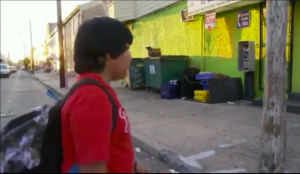Hartford in the 1960s and 1970s had a large Puerto Rican migrant community, who predominantly spoke Spanish. Throughout the city there were little to no Spanish or bilingual business, or social welfare programs to help the Puerto Rican community. Maria Colon Sánchez, a Puerto Rican, through activism and politics fought for bilingual education for children. She established in 1972, along with her community, the Ann Street School better known as La Escuelita. La Escuelita throughout the decade after established continued to grow, yet eventually ended. Then in 1989, Sánchez passed away, leaving the fights for bilingual education to her community. Through the decrease of politics, activism, and lack secure funding lead eventually to the end of La Escuelita and decrease over all of bilingual education.
To understand why Puerto Ricans fought for justice, it’s important to understand the connection between Hartford and Puerto Rico. In the twentieth century, there was a growth of Puerto Rican migrants into Hartford due to demand of work in the tobacco fields. As time went on, more and more Puerto Ricans came into Hartford, and it’s important not to forget that this was a because Connecticut was bringing Puerto Ricans into the Hartford community. Hartford was known to bring Puerto Ricans from the island to the their tobacco farms in Connecticut. Maria Colon Sánchez was born and raised in Comerio, Puerto Rico, and moved to Hartford at the age of 28 in 1954 in search for a better life in the mainland. In fact, one of her first jobs before she opened up her own store was working in the tobacco fields.
In 1969 Sánchez seized the opportunity to mobilize when the riots broke out. This was a heightened time when there was more pressure from the community for ethnic awareness. There was racial discrimination throughout Hartford (José E. Cruz, 1997). The black and Puerto Rican community were left with little not option for social mobility. They were constantly being attacked by the police. Maria noticed that all over Hartford there was no representation that would allow Puerto Ricans to feel supported in their city. Puerto Ricans were marginalized in the city if Hartford. Sánchez was a known leader, that because an activist, and eventually politician to fight for bilingual education that Puerto Ricans deserved (Cruz, 1997). Bilingual education was important to her, because she knew that having a bilingual education would give children the tools to gain social mobility.
Sánchez along with University of Hartford professor Perry Alan Zirkel, worked on create the Teacher Corps in 1971. The way they were able to gain teachers was through the earlier program she establish, Teachers Corps. Teacher Cops helped search and hire teachers who “promoted improved education [and] who could better communicate with and assist students”. La Escuelita was strictly bilingual teachers, they were recruited from Puerto Rico.
In addition from searching for teachers, Sánchez helped develop how bilingual education will look in La Escuelita. La Escuelita opened in the 1972, “Harford received a Title VII grant to establish a bilingual program in the Ann Street Annex to the Barnard Brown School” (Perry A. Zirkel, p.8). La Escuelita, was a schooled controlled by the people for the people. The plans for the school were made from the Spanish-speaking community, parents of students were also involved. Parents were not only involved in the planning, but also were a part of some night classes. Throughout this era of political development, there was a lot of mobilization and civic engagement from the community. La Escuelita was funded by three sources, the Federal department of Health, Education and welfare, the city board of education, and the model cities program. The school focused on individualism, since the school occupied about 200 students and many were at different levels and had different paces of learning (Elissa Papirno, 1973).
In order to continue to preserve La Escuelita, in 1973 Sanchez joined the board of Education, and was there for 16 years. According to Ruth Gasser in Aqui me Quedo, “While a 1968 Federal Law enabled schools to begin to establish bilingual education programs, local school system such as Hartford’s were resistant to such approach.” The Board of Education “believed Puerto Ricans should just learn English like the other immigrants did” (Cruz, 1997). The Board of Education was not in favor of granting bilingual education. Once she joined the board of education she was able to preserve it. She was the representation the community needed. Even with this win, “there were no libraries, assembly hall, or places to play in (Papirno, 1973). So even with the school being bilingual, you can see that there’s still a lot of work to be done.
La Escuelita eventually ended, though the answered seems unclear. The school seemed strong, it was a school built for and by the community. So why did the school end? There were many things that lead to the end of La Escuelita.
In 1977 Hartford Courant explained, that the personnel form the Hartford Public Schools were preparing for the Title XII bilingual education grant proposal for continued federal support. Then, in 1982, La Escuelita gained momentum. The school was still dealing with financial issues, but La Escuelita started serving 336 and was expected to serve 487 Spanish speaking students. The school director at the time, Edna Soler, was weary because the Reagan administration at the had a “commitment to cut federal aid to education and to dismantle the U.S Department of Education, which funds the [bilingual] program” (C.L Smith Muñiz). There were other rumors of the school moving into another school, due to financial cuts. Potentially the school had no more money, and adapted the bilingual program into other schools to save money.
At this time, there was found little information of the involvement of Sánchez in the request of fund.
Bilingual education is meant to help students appreciate and value two languages at the same level. While “dual-langue” was not the terminology used back then, essentially that was what La Escuelita was. Yet, when La Escuelita started parents insisted that gym teachers learn American games “so they can better get along with their American playmates” (Papirno 1973). In addition, the head teacher Edna Soler at the time said, “the community knows children have to learn English to integrate themselves into American society” (Papirno 1973). Bilingual education was built for the people by the people, in order to achieve social mobility, and in general gain a better education to have a better life. In the United States, socially, one must learn English to “succeed”, so there was emphasis from parents and the community to learn English. To learn English one must first be taught academic Spanish, in order to smoothly transition to learning academic English. This was the purpose of La Escuelita, to teach students to hold on to their “culture while still functioning in the United States (Glasser, 1997). La Escuelita, obviously, taught students to value their culture and language, but also promoted that the obtainment of English would maximize opportunity to “fit in” and create social mobility.
In addition, to the mission being lost, according to the Connecticut History website Sanchez won a lawsuit “mandating Hartford Public schools adopt bilingual education.” Sánchez was crucial part for Hartford to establish bilingual education, and while she helped establish La Escuelita, her vision of education equality did not stop there. She fought for all public school in Hartford to adopt some form of bilingual education. This left La Escuelita in a vulnerable position, because now it was not about preserving bilingual education in one school but all public schools. Sánchez was a political leader, and at the time she might have been more focused on politics and bigger things. In 1988 she was the first Latina to win a seat in the Connecticut general assembly (Connecticut History,). Maria Colon Sánchez passed away on 1989, leaving bilingual education in Hartford to be protected by the people.
In conclusion, the Maria Colon Sánchez helped establish La Escuelita, and bilingual education in Hartford. Puerto Ricans in Hartford were angry for the constant inequalities they faced in the city. In 1969, Hartford residents were at a breaking point, so the riots began. Different groups came together and raised hell in Hartford, and for good reasons. After the riots, people saw a the opportunity to organize and mobilize towards creating a more inclusive space. There was leadership development, in which Sánchez had such an important role, because she represented the Puerto Rican community. She was known as “La Madrina”, she was someone who put up a fight to defend Puerto Ricans. With the rise of her leadership, and the help of her community she was able to establish La Escuelita. Not only did Sánchez start La Escuelita, but she helped establish bilingual education in Hartford. There is not a clear answer of why La Escuelita ended, or why bilingual schools have decreased. There is information that points towards multiple reason. It can be explained by financial issues. La Escuelita is no exception for potential decrease of funds, while there is an increase of students attending the school. It might have been due to the fact that many Puerto Ricans are learning English, and embracing English in order to partake in social mobility. Lastly, Sánchez in later years got more political recognition, and while she was heavily involved in establishing La Escuelita, not much information is shown in how present she was throughout the years, since she was busy fighting for bilingual education for all public schools.
The end of La Escuelita and the decrease of bilingual education, can be happening due to the fact that there is a need of someone like Maria Colon Sánchez to organize and mobilize. Currently, there is a new wave on Puerto Rican migrants coming into Hartford after Hurricane Maria in 2017. Now, similarly to the past, there are not enough bilingual program, and those in place lack the programing to help the new wave of youth. Instead of riots, we might see more protest and demonstrations to demand better bilingual program made by the community for the community lead by someone similar to Maria Sánchez Colon.
Cruz, José E. “A Decade of Change: Puerto Rican Politics in Hartford.” Journal of American Ethnic History (1997).
C L SMITH MUNIZ Courant, Staff Writer. 1982. Ann street school to ask U.S. for funds for bilingual program. The Hartford Courant (1923-1993), Jan 15, 1982. https://search.proquest.com/docview/546581618?accountid=14405 (accessed May 4, 2019).
Display ad 163 — no title. 1977. The Hartford Courant (1923-1993), Oct 21, 1977. https://search.proquest.com/docview/545116503?accountid=14405 (accessed May 2, 2019).
Zirkel, Perry A. “Bilingual Education and School Desegregation: A Case of Uncoordinated Remedies.” (1976).
Ubinas, Helen. “The Life and Times of Maria Clemencia Colon Sanchez: Hartford’s Puerto Rican Community’s Matriarch, 1926-1989.” (2001).
“Maria Sánchez, State Representative and Community Advocate.” Connecticut History | a CTHumanities Project. Accessed May 01, 2019. https://connecticuthistory.org/maria-sanchez-state-representative-and-community-advocate/.
Glasser, Ruth. Aquí Me Quedo: Puerto Ricans in Connecticut. Middletown, CT: Connecticut Humanities Council, 1997.
PAPIRNO, ELISSA. 1973. Puerto rican children getting bilingual education at la escuelita. The Hartford Courant (1923-1993), May 28, 1973. https://search.proquest.com/docview/551605629?accountid=14405 (accessed April 29, 2019).
Ross, Jackie. 1975. Board backs plea for school funds. The Hartford Courant (1923-1993), Feb 19, 1975. https://search.proquest.com/docview/542733357?accountid=14405 (accessed May 3, 2019).


